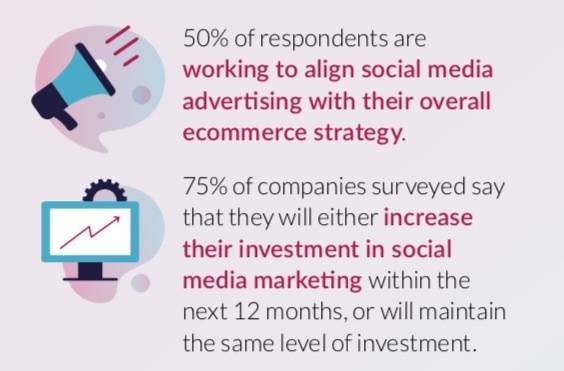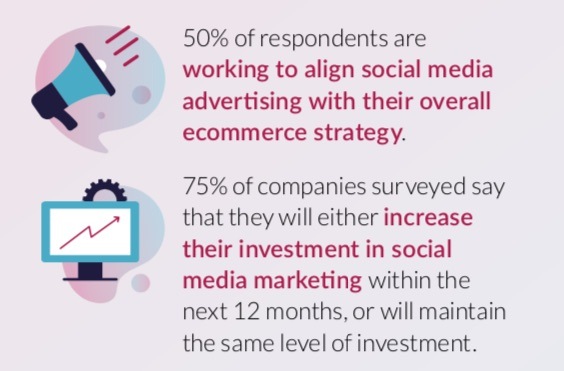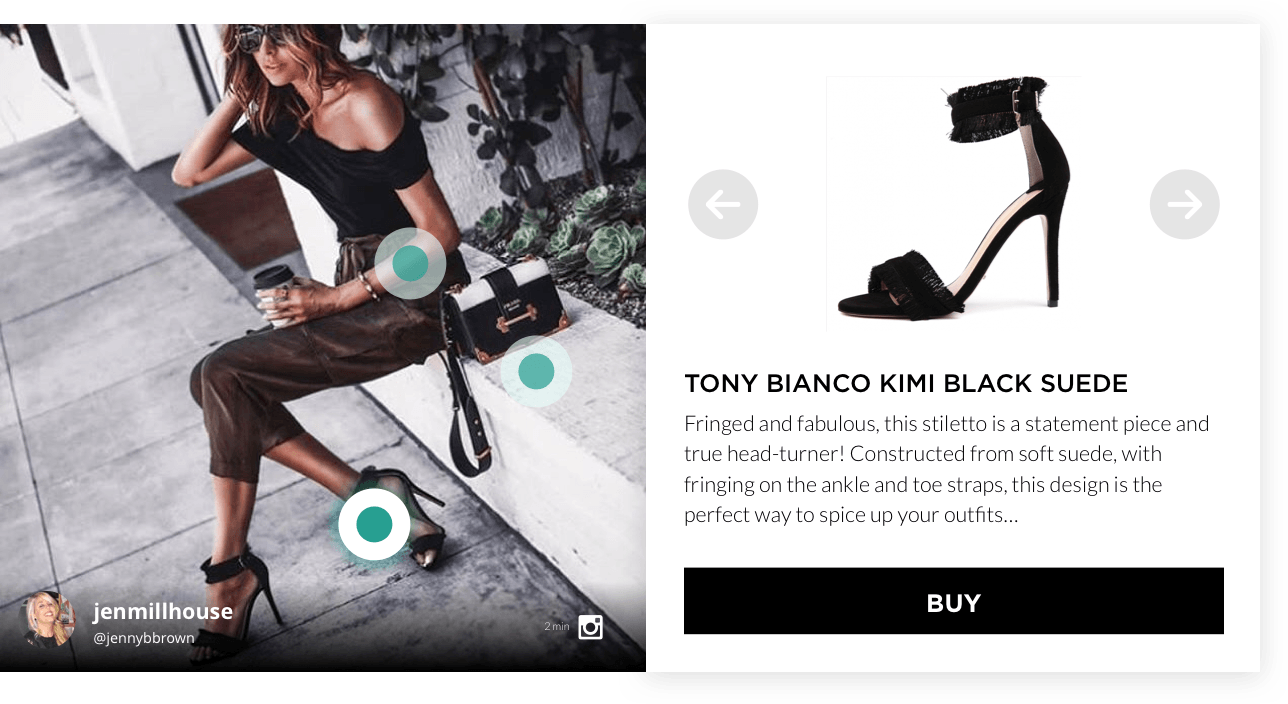SOCIAL
8 Social Commerce Strategies to Win Consumers’ Hearts and Wallets in 2020

Although the vast majority of retail purchases are still made in-store, global online sales are on the rise, and are expected to account for over 22% of all retail sales by 2023. In fact, eCommerce has already begun to overtake physical store sales in some cases. According to a U.S. Commerce Department report, the total market share of online U.S. retail sales were higher than general merchandise sales for the first time in history last February.
It’s easy to see why brands are increasingly prioritizing their investment in online sales. A recent survey of over 200 retail executives by eTail and Stackla found that 50% of retail brands are currently working to align social media advertising with their overall eCommerce strategy, and 75% say they will increase or maintain their investment in social media marketing within the next 12 months.

With all the trends pointing towards the 2020s being the decade of eCommerce, brands will be working harder than ever to capitalize on this inflection point between commerce and social media – more commonly referred to as ‘social commerce’.
In this post, we’ll go over eight winning social commerce strategies to help retailers build consumer trust and boost online sales in 2020:
Know (and Grow With) Your Customers
At a time when there is more competition for shoppers’ attention than ever before, marketers’ success will hinge on their ability to understand their customers’ behaviors, and adjust their strategies to create the most optimized shopping experiences everywhere those customers are.
Invest in the Right Channels
There’s a huge range social and digital platforms that people around the world use every day, however, brands have finite budgets and resources to put towards digital advertising. The better you know your customers, the better you’ll be able to pinpoint the right channels to focus your marketing efforts around.
Which channels do they use to browse and share content? When do they typically use those channels? What types of content do they engage with most? Getting answers to these questions and others like it will go a long way towards informing a winning social commerce strategy for your brand.
Always Be Optimizing
As new platforms emerge, and your customers’ behaviors continue to evolve, so too must your social commerce strategy. Just because a particular channel or strategy has worked in the past, that doesn’t necessarily mean it will be fruitful in the future.
Marketers today have troves of consumer data at their fingertips, but the challenging part is making sense of it all. Investing in analytics platforms and tools can help you efficiently synthesize large (and often siloed) datasets into actionable insights. Just remember, as Like Counts continue to be hidden across popular platforms like Instagram and Facebook, it will be important to de-emphasize the role that vanity metrics (such as Likes) play in instructing your overall social strategy.
Create Seamless, Shorter Paths to Purchase
When it comes to modern shopping, convenience is crucial. Brands that can craft an end-to-end purchase process, with as few frictionless steps as possible – across all key channels – will be the ones who most effectively connect with and convert browsers into customers.
To ensure that you capture the right people, in the right place, at the right time, you’ll need a seamless, omni-channel social commerce approach that’s informed by your customer data and insights.
This includes, but is not limited to, leveraging social checkout features, creating eCommerce, shoppable social feeds and integrating your online and in-store experiences.
Leverage Social Checkout Features
When someone’s scrolling through their favorite social feed and they discover a product that they instantly want to buy, the last thing a brand wants to do is create even the smallest barrier between that moment of inspiration and that person making a purchase.
Until recently, this scenario would force brands to direct that shopper to a link in its bio, which would take the shopper to its mobile site, where they would have to search for the item they had just seen in order to purchase it – and by that time, a good percentage of people would have already dropped off.
As every eCommerce manager knows, fewer clicks = higher sales.

To help optimize social shopping experiences, platforms like Instagram, Facebook and Snapchat have begun testing checkout features which enable brands to seamlessly sell products directly from their organic or paid social posts, without users ever leaving the app. Other platforms, like Pinterest, are also working towards this goal, by offering brands the ability to add product tags to their posts in an effort to streamline the path to purchase.
Showcase On-Site Social Proof and Shoppable Content
Brands shouldn’t just be making it easy for people to “shop the look” on social platforms. Incorporating visual and actionable social proof into your eCommerce approach is also a proven way to boost online engagement, as well as sales. In fact, customers are 6x more likely to purchase a product if the page includes pictures from social media.
Create an interactive lookbook or visual catalog of social content, then add ‘Buy Now’ calls-to-action to drive people directly to purchase pages.

Leverage User-Generated Content and Organic Influencers
User-generated content (UGC) – the images, videos and reviews that people post on social networks – is viewed as the most trusted, authentic and influential content by consumers, making it an incredibly valuable resource for marketers to leverage.
In fact, UGC is seen as 9.8x more influential than traditional influencer content. This trend points to the fact that today’s social influencers are closer to reality TV stars than they are to your average customers – and are experiencing declining consumer trust because of it. As a result, retailers should consider shifting their influencer marketing strategies away from paid macro-influencers and towards organic influencers instead.
I’ve made this case in a previous Social Media Today article, arguing that brands’ organic advocates are their greatest content creators, and companies that can find, engage and strategically motivate those genuine creators in 2020 stand to build more loyal and engaged communities, while delivering authentic content experiences that drive real retail results.
Create Authentic Experiences Throughout the Buyer’s Journey
Most marketers who leverage UGC and influencer content tend to do so only on organic social, yet this compelling social proof can also be effective at creating authentic experiences across every point in the buyer’s journey.
As long as you obtain permission from content creators, UGC can be used to drive results on all your channels and campaigns. Use it as fresh creative in digital, social and print ads, feature it in promotional and community emails, showcase it as social proof throughout your websites and mobile apps, display it on your eCommerce pages or even on in-store signage or live event screens.

Get Your Customers Involved
While UGC marketing is typically pretty reactive – finding, curating, rights managing and publishing content after your customers have already posted it – organic influencer programs take a more proactive approach. Once you invite advocates to join an organic influencer community, you can get creative and specific about the kinds of content you’d like them to create about your brand or products. And studies show, they’ll be excited to participate.
Start a social competition, launch a #hashtag challenge, offer rewards points, or host a pop-up event for your fans. Whatever creative campaign or long-term community initiative you launch, make sure the asks to your communities are specific, and that your terms for participation are clear.
Ethically Embrace Chatbots
On-site, mobile app and messenger chatbots have become a core way for retailers to engage, inform and promote their products to customers. Facebook Messenger chatbots, in particular, have become a retail favorite, giving brands direct, 1:1, “always-on” interactions with shoppers, and a new way to obtain quantitative as well as qualitative customer data.
However, direct messaging also has the capacity to be extremely invasive, if not used judiciously. If abused, it could result in an irreparable breach of customer trust.
Embrace Chatbots, But Establish Messenger Marketing Best Practices
Any company that engages in messenger marketing should first outline standard practices and policies before launching any direct messaging initiative. While these policies will likely be unique to every company, some standard practices include the development of opt-in, unsubscribe and messaging type and frequency policies.
Get Personal
Consumers expect personalized experiences from brands, and they reward the ones that can provide it.
Almost half of retailers engaged in social commerce (49%) say that it helps them personalize customer experiences, based on behavioral signals and the increased the visibility of their product listings.
There are a number of ways in which brands can personalize experiences across the customer lifecycle, but companies like Amazon have really raised the bar when it comes to providing personalized product recommendations – meaning everyone else is playing catch-up.
Personalize Product Recommendations Based On Browsing and Purchasing Behavior
Personalized recommendations have driven 49% of shoppers to purchase a product they did not initially intend to buy – and it’s easy to see why.
Getting personalization right requires brands to have a deep understanding of a shopper’s intention. By connecting behavioral indicators – previous searches, browsing history and frequency, past purchases, cross-channel engagement, etc – to your recommendation engines (not to mention retargeting ads and email campaigns), you can provide timely and highly relevant content to shoppers that can help move them from “I’m not sure if I need anything else” to “This is exactly what I needed.”
Social commerce has already had a significant impact on the retail industry, and it remains a massive opportunity for brands who can put winning strategies in place.
SOCIAL
Snapchat Explores New Messaging Retention Feature: A Game-Changer or Risky Move?

In a recent announcement, Snapchat revealed a groundbreaking update that challenges its traditional design ethos. The platform is experimenting with an option that allows users to defy the 24-hour auto-delete rule, a feature synonymous with Snapchat’s ephemeral messaging model.
The proposed change aims to introduce a “Never delete” option in messaging retention settings, aligning Snapchat more closely with conventional messaging apps. While this move may blur Snapchat’s distinctive selling point, Snap appears convinced of its necessity.
According to Snap, the decision stems from user feedback and a commitment to innovation based on user needs. The company aims to provide greater flexibility and control over conversations, catering to the preferences of its community.
Currently undergoing trials in select markets, the new feature empowers users to adjust retention settings on a conversation-by-conversation basis. Flexibility remains paramount, with participants able to modify settings within chats and receive in-chat notifications to ensure transparency.
Snapchat underscores that the default auto-delete feature will persist, reinforcing its design philosophy centered on ephemerality. However, with the app gaining traction as a primary messaging platform, the option offers users a means to preserve longer chat histories.
The update marks a pivotal moment for Snapchat, renowned for its disappearing message premise, especially popular among younger demographics. Retaining this focus has been pivotal to Snapchat’s identity, but the shift suggests a broader strategy aimed at diversifying its user base.
This strategy may appeal particularly to older demographics, potentially extending Snapchat’s relevance as users age. By emulating features of conventional messaging platforms, Snapchat seeks to enhance its appeal and broaden its reach.
Yet, the introduction of message retention poses questions about Snapchat’s uniqueness. While addressing user demands, the risk of diluting Snapchat’s distinctiveness looms large.
As Snapchat ventures into uncharted territory, the outcome of this experiment remains uncertain. Will message retention propel Snapchat to new heights, or will it compromise the platform’s uniqueness?
Only time will tell.
SOCIAL
Catering to specific audience boosts your business, says accountant turned coach

While it is tempting to try to appeal to a broad audience, the founder of alcohol-free coaching service Just the Tonic, Sandra Parker, believes the best thing you can do for your business is focus on your niche. Here’s how she did just that.
When running a business, reaching out to as many clients as possible can be tempting. But it also risks making your marketing “too generic,” warns Sandra Parker, the founder of Just The Tonic Coaching.
“From the very start of my business, I knew exactly who I could help and who I couldn’t,” Parker told My Biggest Lessons.
Parker struggled with alcohol dependence as a young professional. Today, her business targets high-achieving individuals who face challenges similar to those she had early in her career.
“I understand their frustrations, I understand their fears, and I understand their coping mechanisms and the stories they’re telling themselves,” Parker said. “Because of that, I’m able to market very effectively, to speak in a language that they understand, and am able to reach them.”Â
“I believe that it’s really important that you know exactly who your customer or your client is, and you target them, and you resist the temptation to make your marketing too generic to try and reach everyone,” she explained.
“If you speak specifically to your target clients, you will reach them, and I believe that’s the way that you’re going to be more successful.
Watch the video for more of Sandra Parker’s biggest lessons.
SOCIAL
Instagram Tests Live-Stream Games to Enhance Engagement

Instagram’s testing out some new options to help spice up your live-streams in the app, with some live broadcasters now able to select a game that they can play with viewers in-stream.
As you can see in these example screens, posted by Ahmed Ghanem, some creators now have the option to play either “This or That”, a question and answer prompt that you can share with your viewers, or “Trivia”, to generate more engagement within your IG live-streams.
That could be a simple way to spark more conversation and interaction, which could then lead into further engagement opportunities from your live audience.
Meta’s been exploring more ways to make live-streaming a bigger consideration for IG creators, with a view to live-streams potentially catching on with more users.
That includes the gradual expansion of its “Stars” live-stream donation program, giving more creators in more regions a means to accept donations from live-stream viewers, while back in December, Instagram also added some new options to make it easier to go live using third-party tools via desktop PCs.
Live streaming has been a major shift in China, where shopping live-streams, in particular, have led to massive opportunities for streaming platforms. They haven’t caught on in the same way in Western regions, but as TikTok and YouTube look to push live-stream adoption, there is still a chance that they will become a much bigger element in future.
Which is why IG is also trying to stay in touch, and add more ways for its creators to engage via streams. Live-stream games is another element within this, which could make this a better community-building, and potentially sales-driving option.
We’ve asked Instagram for more information on this test, and we’ll update this post if/when we hear back.
-

 PPC4 days ago
PPC4 days ago19 Best SEO Tools in 2024 (For Every Use Case)
-

 PPC7 days ago
PPC7 days ago4 New Google Ads Performance Max Updates: What You Need to Know
-

 MARKETING7 days ago
MARKETING7 days agoWill Google Buy HubSpot? | Content Marketing Institute
-
SEARCHENGINES6 days ago
Daily Search Forum Recap: April 16, 2024
-

 SEO6 days ago
SEO6 days agoGoogle Clarifies Vacation Rental Structured Data
-

 MARKETING6 days ago
MARKETING6 days agoStreamlining Processes for Increased Efficiency and Results
-
SEARCHENGINES5 days ago
Daily Search Forum Recap: April 17, 2024
-

 PPC7 days ago
PPC7 days agoHow to Collect & Use Customer Data the Right (& Ethical) Way



